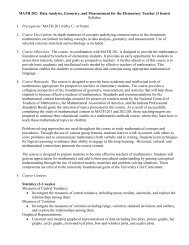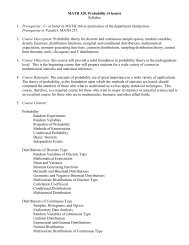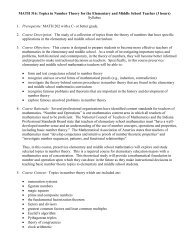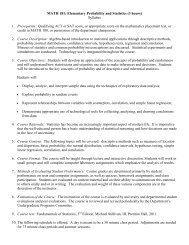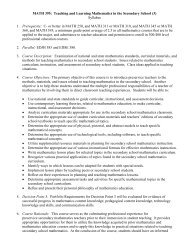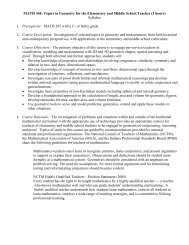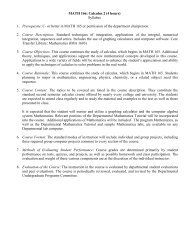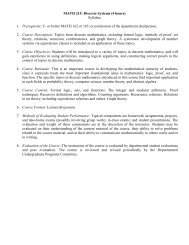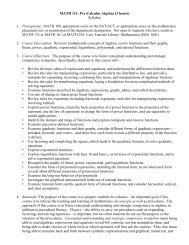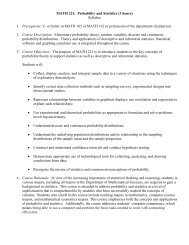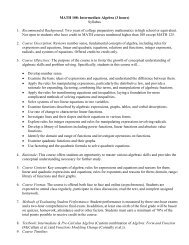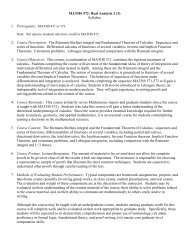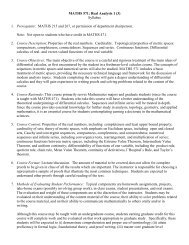MATH 392: Teaching Mathematics to Learners with Disabilities (3 ...
MATH 392: Teaching Mathematics to Learners with Disabilities (3 ...
MATH 392: Teaching Mathematics to Learners with Disabilities (3 ...
You also want an ePaper? Increase the reach of your titles
YUMPU automatically turns print PDFs into web optimized ePapers that Google loves.
<strong>MATH</strong> <strong>392</strong>: <strong>Teaching</strong> <strong>Mathematics</strong> <strong>to</strong> <strong>Learners</strong> <strong>with</strong> <strong>Disabilities</strong> (3)Syllabus1. Prerequisites: <strong>MATH</strong> 207 <strong>with</strong> a C- or better grade or both <strong>MATH</strong> 201 and 202 <strong>with</strong> a C- or better grades.Admittance <strong>to</strong> Teacher Education and permission <strong>to</strong> enroll in 300/400-level professional education courses.Open only <strong>to</strong> special education majors.2. Course Description: Introduction <strong>to</strong> standards, instructional materials and methods, and assessment, <strong>with</strong>emphasis on how these relate <strong>to</strong> the teaching of mathematics <strong>to</strong> learners <strong>with</strong> disabilities. Class ideasapplied in teaching situations. Three one-hour lectures and one one-hour labora<strong>to</strong>ry experience per week.May not be substituted for <strong>MATH</strong> 391.3. Course Objectives: To become familiar <strong>with</strong> state and national mathematics standards. To become familiar <strong>with</strong> available mathematics teaching resources and learn how <strong>to</strong> adapt them forlearners <strong>with</strong> disabilities. To become familiar <strong>with</strong> various mathematics manipulatives and how <strong>to</strong> appropriately use them <strong>with</strong>learners <strong>with</strong> disabilities. To become familiar <strong>with</strong> current pedagogy in teaching mathematics. To develop and evaluate various mathematics assessment strategies. To gain experience in developing appropriate mathematics lesson plans and using those plans <strong>to</strong>teach learners <strong>with</strong> disabilities.4. Course Rationale: This course is designed <strong>to</strong> acquaint students <strong>with</strong> current mathematics pedagogy andprepare them <strong>to</strong> become effective teachers of mathematics <strong>to</strong> learners <strong>with</strong> disabilities.5. Course Content: Problem solving, communication, reasoning and proof, connections, and representationsand how each of these relates <strong>to</strong> teaching mathematics <strong>to</strong> learners <strong>with</strong> disabilities in each of the followingfive content areas: algebra, geometry, measurement, number and operations, and data analysis andprobability. Planning appropriate teaching activities and using appropriate assessment techniques across thefive content areas.6. Course Format: Lecture days will consist of small and/or large group discussions as well as traditionallectures on course content. Labora<strong>to</strong>ry days will consist of supervised teaching of student-prepared lessonsand supervised practice incorporating various instructional strategies. A TI-73 graphing calcula<strong>to</strong>r isrequired.7. Methods of Evaluating Student Performance: May include but not be limited <strong>to</strong> the following: developmen<strong>to</strong>f teaching plans, group and/or individual projects, tests and/or quizzes, writing assignments, professionalpreparation, attendance, and participation, teaching performance.8. Evaluation of the Course: The instruction of the course is evaluated by departmental student evaluations andpeer evaluations. The course is reviewed and revised periodically by the departmental Teacher EducationAdvisory Committee and Undergraduate Programs Committee.9. Addendum:The following are examples of supplemental materials that could be used in teaching this course.Windows of Opportunity: <strong>Mathematics</strong> for Students <strong>with</strong> Special Needs, Carol Thor<strong>to</strong>n and Nancy Bley(Eds.), National Council of Teachers of <strong>Mathematics</strong>, Res<strong>to</strong>n, VA, 1994.
Professional Journals:<strong>Teaching</strong> Children <strong>Mathematics</strong><strong>Mathematics</strong> <strong>Teaching</strong> in the Middle School<strong>Mathematics</strong> TeacherVideotapes:<strong>Teaching</strong> Math: A Video Library, K-4, 5-8, 9-12, Annenberg/CPB Math and Science Collection<strong>Mathematics</strong> <strong>with</strong> Manipulatives by Marilyn Burns[Jan 2001, A. Leitze, L. Robinson, and D. Toll; March 2007, S. Stump; Nov 2010, R. Pierce; Spring 2013, UPCR. Pierce Chair]



